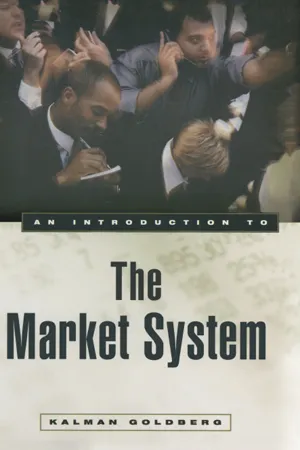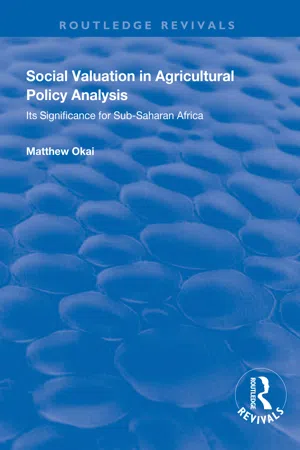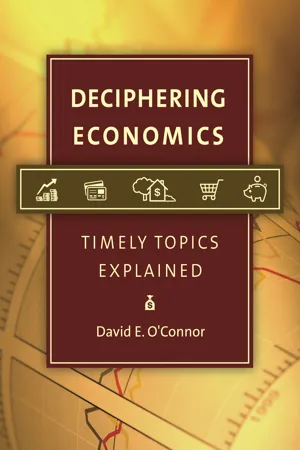Economics
Market Demand
Market demand refers to the total quantity of a good or service that all consumers in a market are willing and able to purchase at various prices during a specific time period. It is determined by the individual demands of all consumers in the market and is influenced by factors such as price, consumer preferences, and income levels.
Written by Perlego with AI-assistance
Related key terms
9 Key excerpts on "Market Demand"
- eBook - ePub
Health Economics For Nurses
Intro Guide
- Stephen Morris(Author)
- 2014(Publication Date)
- Routledge(Publisher)
2 Basic theory of economics: demand, supply and the market solutionIn this chapter we examine the basic aspects of economic theory which lay the foundation for the analysis of the following chapters. The discussion concentrates on the development and explanation of the basic tools of economics: demand, supply and markets, and how they may be used in response to the problem of scarcity. The discussion is general in nature, and is not specifically related to health care or nursing at this stage. These issues will be examined in following chapters.Summary1. The basic problem which economics attempts to address is that of scarce resources. Because of scarcity, all economic decisions necessarily involve a choice in terms of what goods to produce, how to produce them and who shall receive them.2. One way of addressing these issues is to use the notion of a market, in which resource allocation decisions are determined by the independent decisions of consumers and producers, and signals in the form of prices are used to allocate resources.3. There are two components of a market: demand and supply.4. The quantity of a good that consumers are willing and able to buy in a specific time period is called the demand for a good, and is influenced by many variables including the price of the good, income, the prices of other goods and tastes.5. There is, in general, an inverse relationship between the price of a good and the quantity demanded of that good. 6. The demand curve may be derived using the Law of Diminishing Marginal Utility and the assumption that consumers wish to maximise their utility. 7. By supply we mean the quantity of a good that producers will wish to offer for sale at a particular price per time period. 8. The quantity supplied of a good is also influenced by a number of variables, such as the price of the good, the prices of other goods and the costs of production. 9. There is, in general, a positive relationship between the price of a good and the quantity supplied of that good. - eBook - ePub
- Kalman Goldberg(Author)
- 2016(Publication Date)
- Routledge(Publisher)
The demand curves we draw simply illustrate these relationships and reflect the underlying forces. Each demand curve relates a set of inverse price and quantity relationships. If the price of the product changes, the change in behavior is shown by a movement along the curve. If the price of the product has not changed, but more (or less) of it is purchased, then one of the other demand influences-income, tastes, or prices of other goods-has changed and the entire curve shifts. 4 The Market Demand Curve We have spent considerable time examining the decision-making behavior of the household as a consuming unit. However, the individual household is merely one of many buyers of economic goods, and its actions are important only as part of the total market activity of all buyers. The total demand for a good in the market is simply the sum total of the demand of each individual. If at a price of $100 a pair, Smith will buy four pairs of shoes, Jones will buy three pairs, and Brown five pairs, then the total Market Demand at $100 is twelve. The Market Demand at any price, then, is merely the total of the amounts that individuals in the market, acting independently of each other, would buy at each price, and according to their own individual tastes and income. The Business Firm’s Supply The behavior of the consumer helps us understand the demand decisions of each individual and, more important, the effect in the market of the decisions of the total number of individuals about how much of a product they will demand at each price. The business firm makes a supply decision about how much output of a product it will offer for sale. When we have studied supply, we will put the demand and supply behavior and decisions together to see how the actual price of a product is determined in the marketplace - eBook - ePub
Social Valuation in Agricultural Policy Analysis
Its Significance for Sub-Saharan Africa
- Matthew Okai(Author)
- 2019(Publication Date)
- Routledge(Publisher)
Another area of demand theory which originated from the budget studies was pioneered by Ernest Engel (1887), a German economist. His analyses considered demand of a commodity as a function of income only. He demonstrated that demand of a commodity is a relationship between quantities of an item per unit of time that a consumer will take at various levels of income, while holding prices and other factors constant. Engel’s empirical analyses led to the establishment of the following Engel’s law: i) food is the most important item in the household budget; ii) the proportion of total expenditures allocated to food decreases as income rises; iii) the proportion of total expenditure devoted to clothing and housing is approximately constant, while the share of luxury items increases as income rises.Currently the demand theory in the neoclassical approach is based on the concept of the marginal utility of the goods consumed by consumers who are willing to buy a good until its price is below the utility they receive from its consumption. Changes in relative prices will affect the consumption structure assuming that utility received for each good remains constant. There are different compositions of the basket of goods to which the consumer is indifferent, the maximum possible consumption is determined by the total available income. An increase in disposable income raises the overall consumption as well as (probably) the structure of consumption. The elasticity concept measures changes in the consumption of a good when income increases (income elasticity), when price of goods changes (price elasticity) and the price of other goods changes (cross-price elasticity) (Asuming-Brempong, 1992).Consumer Demand
Traditionally a market is the measure of the number of commodities sold at various prices in a given period of time. A market, therefore, measures a flow of commodities. In order to be able to estimate the present and future flow of commodities and their prices, it is necessary to determine the main probable changes in prices over a given period of time. The demand of a commodity is defined as the various quantities of it which consumers are willing to purchase per unit time, all other things remaining ceteris paribus - eBook - ePub
Deciphering Economics
Timely Topics Explained
- David E. O'Connor(Author)
- 2014(Publication Date)
- Greenwood(Publisher)
inner circle shows the flow of the money payments as these payments travel through the American economy. In the factor market, businesses make money payments to households in the form of wages and salaries, interest, rents, and entrepreneurial profits. These money payments, which are the costs of production for businesses, become sources of income for households. Households, in turn, use their income to buy finished goods and services in the product market. This household spending on goods and services becomes revenues for businesses. Business revenues enable firms to buy resources from households—and so the money flow continues. In the American market economy, the flows in both the product market and the factor market are free from most types of government regulation.Demand
A central feature of a market economy is the efficient operation of free markets. A market occurs whenever two or more parties freely exchange something of value. Recall from the circular flow model that there are two primary types of markets, a product market where households buy products from businesses and a factor market where businesses buy resources from households. There are countless exchanges that take place in the U.S. product market and factor market every day. But how are the prices for goods, services, and resources determined? In a market economy, the impersonal forces of demand and supply establish most prices and, in doing so, bring order to the seeming chaos of the marketplace.Demand
Demand is the amount of a good, service, or resource that people are willing and able to buy at a series of prices at a moment in time. The demand for a product or resource is illustrated in tabular form by a demand schedule, or with a demand curve, as shown in Figure 2.4 . The demand curve slopes downward, reflecting the most famous of all economic laws, the law of demand. According to the law of demand , there is an inverse relationship between price and quantity demanded. That is, if the price of a good increases, the quantity demanded will decrease. Conversely, if the price of a good decreases, the quantity demanded will increase.To construct an initial demand curve for a product, economists employ the ceteris paribus assumption. Under the ceteris paribus assumption, all external factors that might affect the demand for the product, except price, are temporarily held constant. In the product market, the demand curve typically represents the viewpoint of the consumer, who buys final goods or services from businesses. In the factor market, the demand curve typically represents the viewpoint of the producer, who buys resources from households. - eBook - ePub
Intermediate Microeconomics
A Tool-Building Approach
- Samiran Banerjee(Author)
- 2014(Publication Date)
- Routledge(Publisher)
Chapter 1Markets
As a segue into the material of intermediate-level microeconomics, we begin with some familiar material from your introductory microeconomics class: Market Demand, supply, and equilibrium. We cover the same material but utilize algebra in addition to graphs. Then, we take up taxes and subsidies, topics which should also be somewhat familiar to you. Finally, we look at various elasticity concepts in greater detail than is usual in a principles-level class.1.1 Market Demand and Supply
Consider a single product (say, the market for steel) over a specific geographical area and a relatively short time period, such as a few months.1.1.1 Plotting a Market Demand function
A Market Demand function shows how much is demanded by all potential buyers at different prices and is written generically asQd= D(p) . Here,Qdis the total quantity demanded and is the dependent variable, while the per-unit price, p , is the independent variable. An example of such a Market Demand function is given by the equationwhereQdis measured in thousands of tons and p in dollars per ton. The fact that the derivative dQd /dpis negative means that this Market Demand embodies the so-called ‘Law of Demand’: keeping all other factors fixed, as the price of a product increases, its quantity demanded decreases .1Figure 1.1 Market DemandSince an independent variable is measured along the horizontal axis and the dependent variable along the vertical, the variable p ought to be on the horizontal axis andQdon the vertical. However, economists customarily put p on the vertical axis andQdon the horizontal axis, thereby depicting theinverse Market Demandby switching the variables in equation (1.1) - eBook - ePub
Executive Economics
Ten Tools for Business Decision Makers
- Shlomo Maital(Author)
- 2010(Publication Date)
- Free Press(Publisher)
The paucity of economic tools for demand analysis is betrayed by many of the demand diagrams in textbooks. These diagrams usually feature the quantity demanded, on one axis, and the price of the product on the other. Yet for a great many goods and services, price is no longer the single most dominating factor. For industrial goods, for instance, price now takes second place in buyers’ surveys to quality.The tool this chapter presents is the demand function—the relation between the amount and type of products consumers buy, and the characteristics of those products and their economic and social environment. Its purpose is to help executives better understand the key factors that drive demand for their products, and those of their competitors, in order to make better decisions with regard to prices, advertising, production, R&D, marketing, and distribution.There are 13 distinct forces that shape Market Demand. By sheer coincidence, they arrange themselves neatly in alphabetical order. They are shown in table 8.1. TABLE 8.1 Thirteen Forces that Shape What People Buy- A aptness
- B bandwagons and bubbles
- C cost, or price
- D demographics
- E elasticity, or sensitivity to price
- F fashion and fads
- G greed
- H habit
- I income
- J jazz
- K knowledge
- L loyalty
- M minds and money
You cannot say it often enough, or loud enough, executives tell themselves repeatedly: “Never lose touch with your customers.” Analyzing these 13 forces can help executives stay in touch with their markets and amplify the noisy, static-ridden signals consumers send them, to better understand why people “vote” for their products with their hard-earned disposable income. Often, the greatest difficulty is to hear not what customers are telling you, but what they are not saying. The price for subacute hearing is steep.For instance, First Boston Corp. was one of America’s most successful investment banking firm in the 1980s. It “became a powerhouse in mergers, mortgage trading and Eurobonds,” all of them growing, profitable markets at that time. But Market Demand shifted—apparently without clearly telling First Boston executives. The new growth markets for investment banks in the 1990s became currency trading, money management, and foreign stocks and bonds. First Boston failed to re-allocate its resources to these new markets. This shows, the Wall Street Journal observed, “how difficult it is for any Wall Street firm to manage the allocation of resources from one area to another as markets wax and wane,”2 - eBook - ePub
An Introduction to Economics
Concepts for Students of Agriculture and the Rural Sector
- Berkeley Hill(Author)
- 2021(Publication Date)
- CAB International(Publisher)
3 Demand and Supply: the Price Mechanism in a Market EconomyIntroductionThe study of the demand and supply of goods and services, and the way they interact, forms a fundamental part of economics. Indeed, a surprisingly high proportion of economic problems we come across in everyday life can be explained, although perhaps not solved, by a careful examination of the demand and supply of goods or services. It has even been suggested that a parrot could be turned into a passable economist simply by teaching it to say the words ‘demand and supply’ in reply to all questions.By way of introduction to this important area of study let us take an example from agriculture. At various times of the year some farmers want to buy barley while others are willing to sell barley – a demand and a supply both exist. Transactions occur at markets where buyers and sellers can meet each other. These used to be physical places but nowadays this could equally well be Internet websites. Let us imagine that we can select one market on one day (say, in early December) and have the power to ask as many questions as we like. Furthermore, let us imagine that we can dictate what the price of barley is to be.If we take all those who wish to buy barley and tell them that the price will be £100/t on that day – assume this is a high price for the particular season – very few farmers will wish to buy any and the quantity sold will be small. If we say that the price will be £90/t, more buyers will be interested. As the price is lowered, increasing interest will be shown – more farmers will wish to buy and each will tend to buy more. If we make a table of the quantity of barley we could sell at various prices we end up with a demand schedule .If we moved on to suppliers of barley we would find that at a low price the quantity which they would be prepared to sell would be small. But if we offered a higher figure the quantities offered would increase – more sellers would want to sell and each would want to sell a greater quantity. Again we could draw up a table or schedule of prices and quantities of barley which suppliers would be prepared to supply at these prices. - eBook - ePub
- Rob Dransfield(Author)
- 2013(Publication Date)
- Routledge(Publisher)
Market forces – changes in demand and supply. The relative strength of demand and supply determines the market prices of goods.Market prices act as signals to producers about the strength of demand for the products they supply. Rising prices act as an incentive for producers to produce more of certain types of goods. In contrast, falling prices will encourage consumers to buy more goods as they become relatively cheaper. Gaining a clear understanding of the four laws of demand and supply will enable you to have a good grasp of how the market works.Key Term3.4 The construction of demand and supply curves Demand and supply curvesChanges in demand and shifts in demand – economists distinguish between a ‘change’ in ‘demand’ (where the whole demand curve changes its position, e.g. as a result of a change in tastes or incomes), and ‘changes’ in ‘quantity demanded’ (i.e. movements along a given demand curve). Changes in quantity demanded result from a change in the price of the good whose demand is being examined.A demand curve is used by economists to illustrate the relationship between price and quantity demanded. It shows demand and changes in quantity demanded. It is useful for business organizations trying to predict the effect of different prices on demand for their products. It helps them to decide how much of a good to make in order to meet quantity demanded.Common sense and personal experience explain the shape of the demand curve. The curve slopes down from left to right because more people can afford to buy goods at lower rather than at higher prices. Existing purchasers of a good will be tempted to buy more of a good at a lower price because they have to give up less of their income to make the purchase. Table 3.4 and Figure 3.1 - No longer available |Learn more
Contemporary Economics
An Applications Approach
- Robert Carbaugh(Author)
- 2016(Publication Date)
- Routledge(Publisher)
- A market is a mechanism through which buyers and sellers communicate in order to trade goods and services. Through the price system, markets link potential buyers with potential sellers.
- Demand is a schedule that shows the amount of a good or service that buyers are willing and able to purchase at each possible price during a particular period. A demand curve is a graphical representation of the data comprised by a demand schedule. A movement along a demand curve, resulting from a change in price, is called a change in quantity demanded.
- According to the law of demand, price and quantity demanded are inversely related, assuming that all other factors affecting the quantity demanded remain the same. Economists explain the law of demand in terms of the substitution effect, the income effect, and the principle of diminishing marginal utility.
- A demand shifter is a variable that causes a shift in a demand curve. Among the most important demand shifters are consumer tastes, the number of buyers, consumer income, the prices of related goods, and expected future prices. When a demand shifter causes an increase in demand, the demand curve shifts to the right; a decrease in demand causes the demand curve to shift to the left.
- Supply is a schedule or curve showing the amounts of a good or service that firms or households are willing and able to sell at various prices during a particular period. The quantity supplied refers to a single point on a supply curve. Changes in quantity supplied are caused by changes in the price of the product.
- According to the law of supply, sellers are willing and able to make more of their product available at a higher price than a lower price, all other determinants of supply being constant. The tendency for the cost of additional output to increase explains the law of supply.
- A supply shifter is a variable that causes a shift in a supply curve. Among the major supply shifters are resource prices, technology, the prices of other goods, expected future prices, taxes and subsidies, and the number of suppliers. When a supply shifter results in an increase in supply, the supply curve shifts to the right; a decrease in supply shifts the supply curve to the left.
Index pages curate the most relevant extracts from our library of academic textbooks. They’ve been created using an in-house natural language model (NLM), each adding context and meaning to key research topics.








